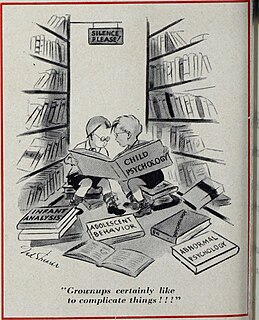
A joke is a display of humour in which words are used within a specific and well-defined narrative structure to make people laugh and is usually not meant to be taken seriously. It takes the form of a story, usually with dialogue, and ends in a punch line. It is in the punch line that the audience becomes aware that the story contains a second, conflicting meaning. This can be done using a pun or other word play such as irony or sarcasm, a logical incompatibility, nonsense, or other means. Linguist Robert Hetzron offers the definition:
A joke is a short humorous piece of oral literature in which the funniness culminates in the final sentence, called the punchline… In fact, the main condition is that the tension should reach its highest level at the very end. No continuation relieving the tension should be added. As for its being "oral," it is true that jokes may appear printed, but when further transferred, there is no obligation to reproduce the text verbatim, as in the case of poetry.

Humour or humor is the tendency of experiences to provoke laughter and provide amusement. The term derives from the humoral medicine of the ancient Greeks, which taught that the balance of fluids in the human body, known as humours, controlled human health and emotion.

Stand-up comedy is a comedy performance to a live audience, addressed directly from the stage.

Black comedy, also known as black humor, dark humor, dark comedy, morbid humor, or gallows humor, is a style of comedy that makes light of subject matter that is generally considered taboo, particularly subjects that are normally considered serious or painful to discuss. Writers and comedians often use it as a tool for exploring vulgar issues by provoking discomfort, serious thought, and amusement for their audience. Thus, in fiction, for example, the term black comedy can also refer to a genre in which dark humor is a core component. Popular themes of the genre include death, crime, poverty, suicide, war, violence, terrorism, discrimination, disease, racism, sexism, and human sexuality.
A punch line concludes a joke; it is intended to make people laugh. It is the third and final part of the typical joke structure. It follows the introductory framing of the joke and the narrative which sets up for the punch line.
"The Aristocrats" is a taboo-defying off-color joke that has been told by numerous stand-up comedians since the vaudeville era. It relates the story of a family trying to get an agent to book their stage act, which is revealed to be remarkably vulgar and offensive in nature, with the punch line revealing that they incongruously bill themselves as "The Aristocrats". When told to audiences who know the punch line, the joke's humor depends on the described outrageousness of the family act.

Self-referential humor, also known as self-reflexive humor or meta humor, is a type of comedic expression that—either directed toward some other subject, or openly directed toward itself—is self-referential in some way, intentionally alluding to the very person who is expressing the humor in a comedic fashion, or to some specific aspect of that same comedic expression. Self-referential humor expressed discreetly and surrealistically is a form of bathos. In general, self-referential humor often uses hypocrisy, oxymoron, or paradox to create a contradictory or otherwise absurd situation that is humorous to the audience.
In psychology, displacement is an unconscious defence mechanism whereby the mind substitutes either a new aim or a new object for goals felt in their original form to be dangerous or unacceptable.
"No soap radio" is a form of practical joke and an example of surreal comedy. The joke is a prank whereby the punch line has no relation to the body of the joke; but participants in the prank pretend otherwise. The effect is to either trick someone into laughing along as if they "get it" or to ridicule them for not understanding.
Anti-humor is a type of indirect and alternative humor that involves the joke-teller's delivering something that is intentionally not funny, or lacking in intrinsic meaning. The practice relies on the expectation on the part of the audience of something humorous, and when this does not happen, the irony itself is of comedic value. Anti-humor is also the basis of various types of pranks and hoaxes.
Sigmund Freud noticed that humor, like dreams, can be related to unconscious content. In the 1905 book Jokes and Their Relation to the Unconscious, as well as in the 1928 journal article Humor, Freud distinguished contentious jokes from non-contentious or silly humor. In fact, he sorted humor into three categories that could be translated as: joke, comic, and mimetic.

Humor research is a multifaceted field which enters the domains of linguistics, history, and literature. Research in humor has been done to understand the psychological and physiological effects, both positive and negative, on a person or groups of people. Research in humor has revealed many different theories of humor and many different kinds of humor including their functions and effects personally, in relationships, and in society.
There are many theories of humor which attempt to explain what humor is, what social functions it serves, and what would be considered humorous. Among the prevailing types of theories that attempt to account for the existence of humor, there are psychological theories, the vast majority of which consider humor to be very healthy behavior; there are spiritual theories, which consider humor to be an inexplicable mystery, very much like a mystical experience. Although various classical theories of humor and laughter may be found, in contemporary academic literature, three theories of humor appear repeatedly: relief theory, superiority theory, and incongruity theory. Among current humor researchers, there is no consensus about which of these three theories of humor is most viable. Proponents of each one originally claimed their theory to be capable of explaining all cases of humor. However, they now acknowledge that although each theory generally covers its own area of focus, many instances of humor can be explained by more than one theory. Similarly, one view holds that theories have a combinative effect; Jeroen Vandaele claims that incongruity and superiority theories describe complementary mechanisms which together create humor.
Certain words have been suggested to be inherently funny. Vaudeville tradition holds that words with the letter k are funny. A 2015 study at the University of Alberta suggested that the humor of certain nonsense words can be explained by whether they seem rude, and by the property of entropy; the improbability of certain letters being used together in a word. The philosopher Arthur Schopenhauer posited that humor is a product of one's expectations being violated.

Comedy is a genre of fiction that consists of discourses or works intended to be humorous or amusing by inducing laughter, especially in theatre, film, stand-up comedy, television, radio, books, or any other entertainment medium. The term originated in ancient Greece: in Athenian democracy, the public opinion of voters was influenced by political satire performed by comic poets in theaters. The theatrical genre of Greek comedy can be described as a dramatic performance pitting two groups, ages, genders, or societies against each other in an amusing agon or conflict. Northrop Frye depicted these two opposing sides as a "Society of Youth" and a "Society of the Old". A revised view characterizes the essential agon of comedy as a struggle between a relatively powerless youth and the societal conventions posing obstacles to his hopes. In this struggle, the youth then becomes constrained by his lack of social authority, and is left with little choice but to resort to ruses which engender dramatic irony, which provokes laughter.

Jokes and Their Relation to the Unconscious is a 1905 book on the psychoanalysis of jokes and humour by Sigmund Freud, the founder of psychoanalysis. In the work, Freud describes the psychological processes and techniques of jokes, which he compares to the processes and techniques of dreamwork and the unconscious.
Affective disposition theory (ADT), in its simplest form, states that media and entertainment users make moral judgments about characters in a narrative which in turn affects their enjoyment of the narrative. This theory was first posited by Zillmann and Cantor (1977), and many offshoots have followed in various areas of entertainment. Entertainment users make constant judgments of a character's actions, and these judgments enable the user to determine which character they believe is the "good guy" or the "villain". However, in an article written in 2004, Raney examined the fundamental ADT assumption that viewers of drama always form their dispositions toward characters through moral judgment of motives and conduct. Raney argued that viewers/consumers of entertainment media could form positive dispositions toward characters before any moral scrutinizing occurs. He proposed that viewers sometimes develop story schemas that provide them "with the cognitive pegs upon which to hang their initial interpretations and expectations of characters". The basic idea of the affective disposition theory is used as a way to explain how emotions become part of the entertainment experience.
Cognitive humor processing refers to the neural circuitry and pathways that are involved in detecting incongruities of various situations presented in a humorous manner. Over the past decade, many studies have emerged utilizing fMRI studies to describe the neural correlates associated with how a human processes something that is considered "funny". Conceptually, humor is subdivided into two elements: cognitive and affective. The cognitive element, known as humor detection, refers to understanding the joke. Usually, this is characterized by the perceiver attempting to comprehend the disparities between the punch line and prior experience. The affective element, otherwise known as humor appreciation, is involved with enjoying the joke and producing visceral, emotional responses depending on the hilarity of the joke. This ability to comprehend and appreciate humor is a vital aspect of social functioning and is a significant part of the human condition that is relevant from a very early age. Humor comprehension develops in parallel with growing cognitive and language skills during childhood, while its content is mostly influenced by social and cultural factors. A further approach is described which refers to humor as an attitude related to strains. Humorous responses when confronted with troubles are discussed as a skill often associated with high social competence. The concept of humor has also been shown to have therapeutic effects, improving physiological systems such as the immune and central nervous system. It also has been shown to help cope with stress and pain. In sum, humor proves to be a personal resource throughout the life span, and helps support the coping of everyday tasks.
Sad clown paradox is the contradictory association between comedy and mental disorders such as depression and anxiety. These comedic performers are characterised by feelings of deprivation and isolation in their early lives, where comedy evolves as a release for tension, removing feelings of suppressed physical rage through a verbal outlet.







